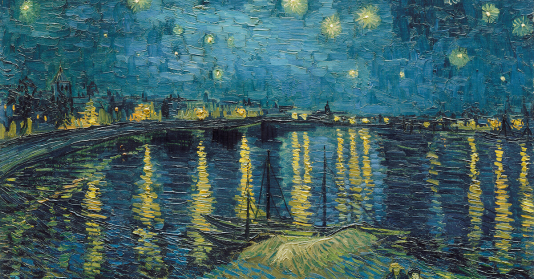Vincent van Gogh’s “Starry Night Over the Rhone,” painted in September 1888, is a magnificent work that captures the serene beauty of the night sky reflected in the Rhône River in Arles, France. This painting, like many of van Gogh’s works, showcases his unique techniques and the materials that contributed to his distinctive style. By examining the brushwork, color palette, and materials used, we can gain deeper insights into the creation of this iconic masterpiece.
Brushwork
Van Gogh’s brushwork in “Starry Night Over the Rhone” is a testament to his dynamic and expressive painting style. He employed a variety of strokes to convey different textures and emotions within the scene. The sky, for instance, features swirling, rhythmic strokes that create a sense of movement and fluidity. These brushstrokes are thick and bold, applied with a confidence that captures the energy of the night sky.
In contrast, the water of the Rhône is depicted with horizontal strokes that mimic the gentle ripples on the river’s surface. Van Gogh’s use of short, staccato brushstrokes in this area gives the water a shimmering quality, reflecting the lights from the gas lamps along the quay. This technique not only adds a realistic touch but also enhances the overall atmospheric effect of the painting.
The stars and gas lamps are painted with impasto, a technique where paint is laid on the canvas in very thick layers. This creates a textured, almost three-dimensional effect that makes the stars appear to glow and the lamps to radiate light. This use of impasto is characteristic of van Gogh’s work and contributes to the luminous quality of “Starry Night Over the Rhone.”
Color Palette
Van Gogh’s color palette in “Starry Night Over the Rhone” is both vibrant and harmonious, reflecting his keen sense of color and its emotional impact. The dominant colors in the painting are blues and yellows, which create a striking contrast that is both visually appealing and evocative.
The sky is rendered in deep, rich blues, ranging from dark indigo to lighter, more vibrant shades. These blues are contrasted with the bright yellow and white of the stars and the reflections in the water. The use of complementary colors (blue and yellow) enhances the vibrancy of the scene, making the stars and reflections stand out against the dark sky and water.
Van Gogh also used greens and oranges to add depth and complexity to the color scheme. The greenish hues in the water and the orange tones in the lights from the gas lamps provide a balance to the dominant blue and yellow, creating a more nuanced and sophisticated palette.
The artist’s application of color is not just about depicting reality but also about conveying emotion. The cool blues evoke a sense of calm and tranquility, while the warm yellows and oranges add a touch of warmth and comfort. This interplay of colors helps to create a mood that is both serene and uplifting, capturing the quiet beauty of the night.
Materials
Van Gogh used oil paints on canvas for “Starry Night Over the Rhone,” a medium that allowed him to achieve the rich textures and vibrant colors seen in the painting. Oil paint is known for its versatility and depth of color, which made it the perfect choice for van Gogh’s expressive style.
One of the key advantages of oil paint is its slow drying time, which allows the artist to work and rework the paint over an extended period. This was particularly beneficial for van Gogh, who often applied paint in thick layers and used various techniques to create texture. The slow drying time also enabled him to blend colors directly on the canvas, achieving the smooth transitions and rich gradients evident in the sky and water.
Van Gogh’s choice of canvas was also significant. He typically used a coarse, woven canvas that provided a textured surface, enhancing the overall tactile quality of his work. This texture is particularly noticeable in the impasto areas, where the thick paint interacts with the rough surface of the canvas to create a striking visual effect.
Conclusion
In “Starry Night Over the Rhone,” Vincent van Gogh’s technical mastery is evident in his use of brushwork, color palette, and materials. His dynamic brushstrokes bring the night scene to life, while his sophisticated use of color creates a harmonious and emotionally resonant image. The choice of oil paint and canvas allowed him to achieve the rich textures and vibrant colors that characterize his work.
This painting is a brilliant example of van Gogh’s ability to convey both the physical beauty and the emotional essence of his subjects. By examining the techniques and materials used in “Starry Night Over the Rhone,” we gain a deeper appreciation for van Gogh’s artistic genius and the timeless appeal of his work.






